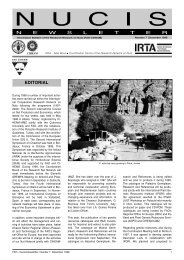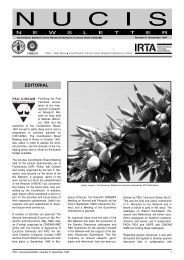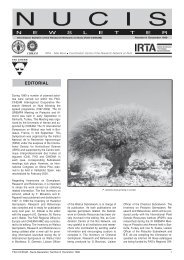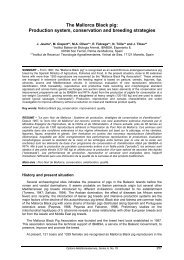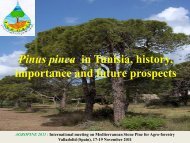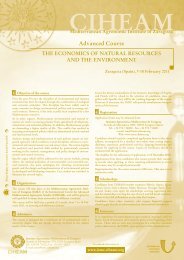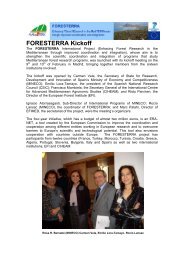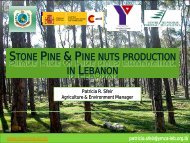NUCIS number 12. September 2004. 52 pages (full ... - IAMZ - ciheam
NUCIS number 12. September 2004. 52 pages (full ... - IAMZ - ciheam
NUCIS number 12. September 2004. 52 pages (full ... - IAMZ - ciheam
- No tags were found...
You also want an ePaper? Increase the reach of your titles
YUMPU automatically turns print PDFs into web optimized ePapers that Google loves.
Figure 4. Agarose gel showing some cultivarswith a positive reaction to PNRSV primers.Lane 1: molecular marker ladder,lane 2: Carmel(-ve), Lane 3: Fritz (+ve),lane 4: Johnston (-ve), lane 5: Mission (-ve),lane 6: Nonpareil (+ve), lane 7: Nonpareil (-ve),lane 8: Parkinson (+ve), lane 9: Peerless (+ve),lane 10: Price (+ve), lane 11: Price (-ve),Lane 12: negative controlMONASHThe ELISA technique was used to screenall the Monash trees for PNRSV and PDVover 1997, 1998, & 1999 and half thetrees in 2000. PDV was not detected inany of the trees, however PNRSV wasdetected in 34 trees in 1997, 33 trees in1998, and 36 trees in 1999. Where treestest positive one year and negative thenext, this may be due to uneven distributionof the virus in the plant, or seasonalfluctuations of viral concentrations due toextremes of temperature. The increasefrom 1997 to 1999 may be attributed to anincrease in the virus titre of these trees tolevels able to be detected by ELISA, ormay represent new infections.RT-PCR TECHNIQUEA DNA based technique for virus detectionwas developed by G. Collins. This techniqueis based on the reverse transcription-polymerasechain reaction (RT-PCR)and is more sensitive than ELISA. The techniqueinvolves extracting ribonucleicacid (RNA) from fresh leaves and usingspecially designed primers that can detectthe viral coat protein within the plantcells. This technique was used on trees atMonash in 2000, 2001, 2002 and 2003.Generally RT-PCR confirmed the resultsof ELISA, however some trees were positivefor PNRSV where ELISA gave negativeresults. This is due to the more sensitivenature of RT-PCR, and has theadded advantage that plant material canbe tested at any time throughout thegrowing season.ACKNOWLEDGEMENTSThanks to Wanli Ma for technical assistancewith the RT-PCR. Thanks to the AlmondBoard of Australia, HorticultureAustralia Limited and Australian ResearchCouncil for funding. Reproducedwith permission from The AustralianNutgrower Journal.REFERENCESBertozzi, T., Alberts, E., and Sedgley,M. 2002. Detection of Prunus necroticringspot virus in almond: effect of samplingtime on the efficiency of serologicaland biological indexing methodologies.Australian Journal of ExperimentalAgriculture, 42: 207-210.Sedgley, M., and Collins, G. G. 2002.The Australian almond breeding programme.Acta Horticulturae, 591: 241-244.M. Wirthensohn 1 , S. Ramesh 1 , T. Bertozzi 2 ,E. Alberts 3 , G. Mekuria 4 , C. Bennett 5 ,G. Collins 1 , and M. Sedgley 11School of Agriculture & Wine, Universityof Adelaide, Waite Campus, PMB 1 GlenOsmond, SA 5064 Australia.2Present Address: Evolutionary Biology Unit,South Australian Museum, North Terrace,Adelaide, SA 5000 Australia.3South Australian Research and DevelopmentInstitute, GPO Box 397, Adelaide, SA 5001Australia.4Present address: Department of NaturalResources and Environment (Victorian Institutefor Dryland Agriculture), Private Bag 260,Horsham, Vic 3401 Australia.5Almond Board of Australia, HorticultureHouse, PO Box <strong>52</strong> Berri, SA 5343 Australia.E-mail: michelle.wirthensohn@adelaide.edu.auTHE PISTACHIO INDUSTRYIN ITALY: CURRENT SITUATIONAND PROSPECTSINTRODUCTIONPistachio (Pistacia vera L.), is a dioeciousand deciduous species native to westernAsia and Asia Minor. It was introducedinto Italy from Syria in 30 A.D. by the RomanGovernor of that Province, Lucius Vitellio,at approximately the same time itwas introduced in Spain (Minà Palumbo,1882). Its introduction into Sicily, whichnowadays accounts for almost the entirePistachio industry in Italy, probably occurredsome time later, following an initialperiod of cultivation in Campania which atthat time represented the roman “countryside”.Its cultivation in Sicily began tospread during the Arab domination (827-1040 A.D.) together with other major fruitand vegetable species and in parallel withthe improvement of the agronomic techniques.As a matter of fact, the Sicilian dialectalterm for Pistachio tree (Fastuca) isof arab derivation (Fustuq). However,very little is known until recent timesabout its distribution over the region. Historicreferences onto Pistachio cultivationare documented by the XVIIth century,even if first official records of the economicimportance of Pistachio industry arereferred to the first decades of the XXcentury.Soon after the second world war the entirestructure of the Sicilian Pistachio industryunderwent significant changes.The relative importance of the traditionalcultivation areas (Agrigento, Caltanissettaand Palermo) strongly decreasedwith the abandonment of large part of thePistachio cultivation which was partiallycompensated by a parallel increase of theproduction in the Catania Province (Fig. 1).Currently more than 90% of the total ItalianPistachio area is concentrated in onlyfew territories in the eastern Sicily (westernslopes of Mount Etna volcano), mainlylocated in the districts of Bronte andAdrano (Catania Province), onto approximately4.500 hectares. Few residuals ofthe past cultivation can still be found inCaltanissetta and Agrigento Provinces, insmall and scattered surfaces (as a whole,130 ha in specialized cultivation and 210ha in mixed cultivation).Despite this ancient origin and the longperiod of cultivation, only few female varietiesof Pistachio are now grown in Italy(about ten) together with an even morerestricted <strong>number</strong> of unnamed male selections.Among the female cultivars,‘Bianca’ (synonym: Napoletana) is practicallythe only cultivar grown, other varieties,namely ‘Femminella’, ‘Natalora’,‘Agostana’, ‘Silvana’, ‘Insolia’, ‘Cerasola’,‘Cappuccia’, representing not more than3% of the total (Barone et al., 1985) canstill be found, mostly in scattered, abandonedsettlements. This genetic pool isprobably the result of a two step introductionprocess of genetic material (Baroneet al., 1996) coincident with the earliestintroduction from Syria of the reddish ‘Cerasola’by the Romans and the later introductioncarried out by the Arabs. The reasonsof this low <strong>number</strong> of varieties isthought to be the exclusive use by thegrowers of vegetative propagation sinceancient times due to the long juvenilityperiod of P. vera seedlings, the long lifespanof the trees and easy hybridizationswith other Pistacia species. Nevertheless,within the Sicilian Pistachio germplasm,some valuable fruit characteristics suchas colour, flavour and nut quality arehighly appreciated in trade, specially thegreenness of the kernels and the rich oilynut-like flavour (Woodroof, 1967). Most ofthese appreciated characteristics havebeen maintained also by cultivars obtainedin the United States from Sicilianseeds imported in the early 1900’s suchas ‘Bronte’ and ‘Trabonella’ (Joley, 1969).In spite of these valuable characteristicsof the Italian pistachios, the contributionof Italian production represents nowadaysonly less than 0.6% of the world production.Nevertheless, with respect to productdestination, it is remarcable that Ita-16 FAO-CIHEAM - Nucis-Newsletter, Number 12 <strong>September</strong> 2004



